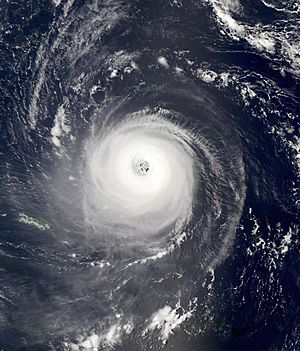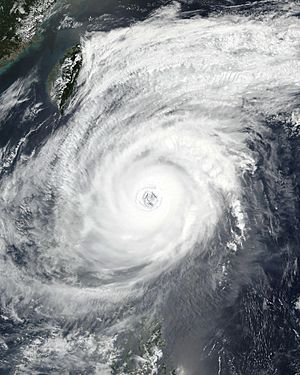Annular tropical cyclone facts for kids

An annular tropical cyclone is a special kind of tropical cyclone. It has a normal or large eye in the middle. This eye is surrounded by a thick, even ring of strong thunderstorms. These storms often don't have the usual rainbands. They also look very balanced and round overall. Because of this, an annular tropical cyclone can look like a tire or a doughnut from above.
Tropical cyclones can become annular as they get stronger. These storms are special because they can resist bad weather conditions better than other storms. This means they often stay strong for a longer time. Most of what we know about annular tropical cyclones comes from satellite imagery and aircraft reconnaissance. This is because they usually form far out over the ocean, away from land.
Contents
What Makes Them Special?
How Scientists Identify Them
Scientists John Knaff and James Kossin first described annular hurricanes in 2002. They used infrared satellite images to spot them. They said an annular tropical cyclone must have an average or larger eye. This eye must be surrounded by deep thunderstorms for at least three hours. Also, there should not be many thunderstorms far from the storm's center. This means annular storms usually don't have the typical rainbands. These features make the storm look very balanced and round.
If a storm doesn't show these features, it's called asymmetric. When storms become annular, the daily changes in their high-level clouds become less noticeable. Some annular tropical cyclones also have a "pinwheel eye." This is when the eye looks like a spoked wheel.
The Annular Hurricane Index
Scientists have created a tool to find annular tropical cyclones in real-time. It's called the Annular Hurricane Index. The National Hurricane Center (NHC) now uses this tool. It looks at things like cloud height and the size of the eye using satellite images. Then, it gives the storm a score, with 100 being the highest. A score of zero or less means the storm is not annular. Positive scores mean it is, and higher scores mean it has more annular features.
Strength and Duration
Annular tropical cyclones are usually very strong. Their average maximum sustained windspeeds are about 108 kn (124 mph; 200 km/h). A key feature is that they are less likely to weaken from bad weather conditions. Unlike other storms, annular cyclones can keep their strongest intensity for a long time. After reaching their peak strength, they tend to weaken slowly. This makes it hard for forecasters to predict their future strength. For example, between 1995 and 1999, the National Hurricane Center often underestimated the strength of annular hurricanes. They were off by about 18.9 kn (35.0 km/h, 21.7 mph) three days out.
A study of Pacific typhoons from 1990 to 2009 found that only about 4 percent had annular features. This shows they are quite rare.
How They Form
Tropical cyclones can become annular when small swirls of wind inside the eyewall (called eyewall mesovortices) mix strong winds from the eyewall with weaker winds from the eye. This mixing helps the eye get bigger. It also makes the air inside the eye more uniform. This change usually takes about 24 hours. It's a bit like an eyewall replacement cycle. Scientists have also noticed that winds decrease in steps within the storm's strongest wind area. This might mean more wind mixes between the eye and eyewall as storms get stronger. This helps explain why annular features are mostly seen in very strong storms.
Conditions Needed
Annular storms are usually very close to their maximum potential intensity. This means the conditions where they form are generally good for storms to get stronger and last longer. Annular tropical cyclones also need low wind shear. Wind shear is when winds change speed or direction with height. All the annular storms studied in the East Pacific and North Atlantic had easterly winds and cold air high up in the atmosphere. They also had strong outflow, which is air flowing away from the storm. This suggests that the best conditions for annular tropical cyclones are near the equator, on the side of a subtropical ridge.
Interestingly, very warm sea surface temperatures (SSTs) are not needed for annular tropical cyclones. They tend to develop when ocean temperatures are in a specific range, from 25.4–28.5 °C (77.7–83.3 °F).
In the Western North Pacific, good conditions for annular typhoon development are found in two areas. These areas are between 20°N and 30°N latitude. One is in the central part of the basin, and the other is east of Taiwan. In the Eastern North Pacific, these conditions were only present about 3 percent of the time between 1998 and 1999. In the same period, the North Atlantic basin had suitable conditions only about 0.8 percent of the time.
See Also
 In Spanish: Huracán anular para niños
In Spanish: Huracán anular para niños
- Tropical cyclogenesis
- Tropical cyclone forecasting
- Central dense overcast
- Coriolis force



